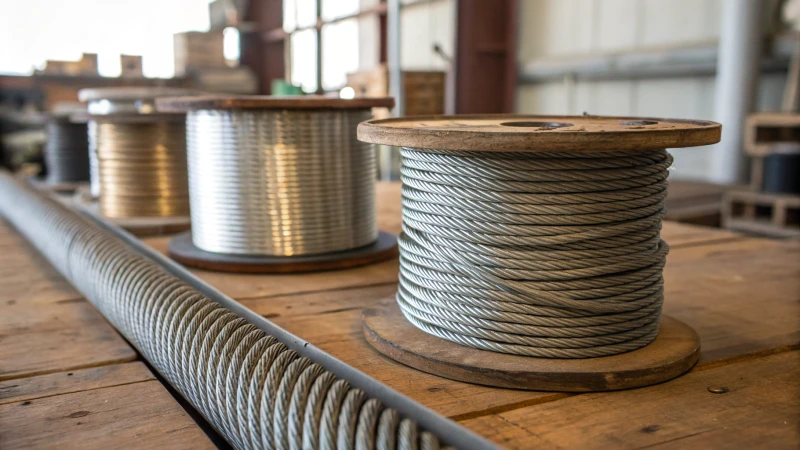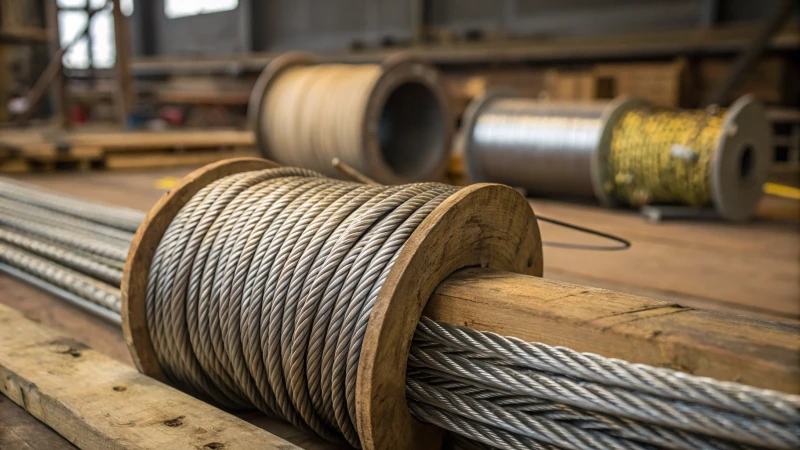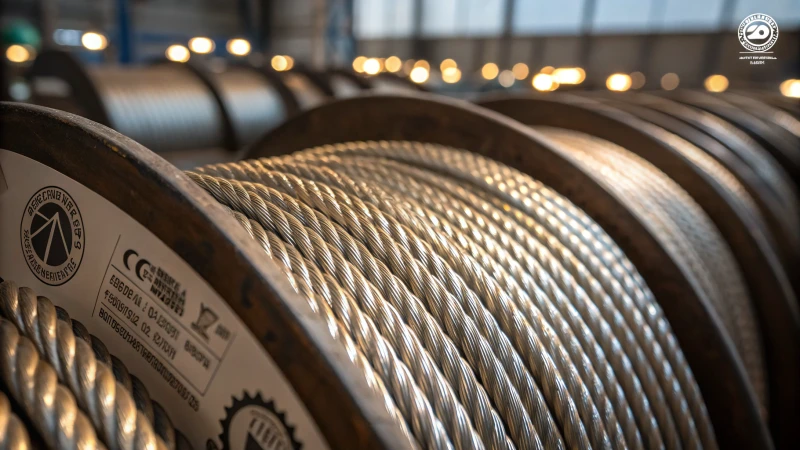
Navigating the options for custom steel wire ropes can feel overwhelming, but choosing the right material makes all the difference.
Choosing the best material for custom steel wire ropes hinges on understanding your specific needs. Stainless steel (AISI 304/316) excels in corrosion resistance, making it perfect for marine environments, while galvanized steel stands up well to the elements for outdoor use. High-strength steel is ideal for heavy lifting. Always weigh cost against performance and necessary certifications.
Every project I've been a part of has taught me that material selection is crucial. It's not just about picking what's popular; it's about finding the perfect match for your project's environment and demands. For instance, I once managed a project where we chose stainless steel because its corrosion resistance was essential for our marine setting. This decision paid off when we faced unexpected harsh weather conditions.
The key is to weigh factors like cost, performance, and certification requirements. While stainless steel might seem pricey upfront, its durability can save costs in the long run, especially in extreme environments. On the other hand, if your project involves more standard outdoor applications, galvanized steel could offer a budget-friendly yet reliable option. By aligning these factors with your specific needs, you can ensure both safety and efficiency in your projects.
Stainless steel wire ropes are best for corrosion resistance.True
Stainless steel, like AISI 304/316, offers high corrosion resistance.
Galvanized steel is unsuitable for outdoor applications.False
Galvanized steel provides good weather resistance for outdoor use.
Why is material selection crucial for steel wire ropes?
Ever stood in the middle of a bustling construction site, wondering why some projects just seem to run smoother than others? I did, and it turns out that selecting the right steel wire ropes is a game-changer.
When choosing materials for steel wire ropes, focus on corrosion resistance, tensile strength, cost-effectiveness, and industry standards. These factors ensure that ropes perform optimally, last longer, and keep operations safe across various applications.

Corrosion Resistance and Environmental Suitability
Picture this: I was once overseeing a project near the coast, battling salty sea air. That's when I realized that using the right materials is crucial. Stainless steel1, like AISI 304 and 316, became my go-to because of its excellent corrosion resistance in such harsh environments. But when I moved inland, galvanized steel did the trick—offering solid weather resistance for outdoor use.
| Material Type | Environment | Benefits |
|---|---|---|
| Stainless Steel | Marine/Chemical | High corrosion resistance |
| Galvanized Steel | Outdoor | Good weather resistance |
Strength and Load-Bearing Capacity
Another time, I was faced with a daunting task: deep well drilling. The stress on the ropes was immense! High-strength steel with a tensile strength of 1200 MPa or above was non-negotiable. It’s like having a reliable teammate who never lets you down, no matter how tough the job.
The tensile strength of the wire rope is crucial, especially in applications requiring heavy lifting or high-stress conditions. The ability to endure such conditions without compromising safety is a key factor in material selection2.
Cost versus Performance Balance
Balancing cost and performance is like walking a tightrope—get it right, and you glide smoothly; get it wrong, and you plummet. I learned this firsthand while budgeting for a project. While stainless steel promises durability and corrosion resistance, galvanized steel helps save costs by 30%-40% without compromising too much on performance in less demanding environments.
Compliance with Industry Standards
In my line of work, cutting corners isn't an option. Material certifications like ISO 9001 or CE aren't just fancy labels—they're guarantees of quality and safety. For example, our stainless steel wires had to ace the rigorous 48-hour salt spray test before I'd even consider them for high-end applications.
Material certification and reliability are non-negotiable in industrial applications. Suppliers with certifications ensure adherence to stringent quality standards.
Additional Considerations
Lastly, factors like fatigue resistance and flexibility also play a pivotal role. During one particularly challenging project, the fatigue-resistant ropes I selected ensured a longer lifespan and smoother operation under varied conditions. Sometimes, it's these small choices that make the biggest difference.
| Consideration | Impact on Selection |
|---|---|
| Fatigue Resistance | Longer lifespan |
| Flexibility | Usability in various applications |
Each of these factors has taught me valuable lessons in choosing the most suitable material for steel wire ropes. They have ensured that my projects not only meet safety standards but also thrive in efficiency and cost-effectiveness.
Stainless steel is best for marine environments.True
Stainless steel offers high corrosion resistance, ideal for marine use.
Galvanized steel is more expensive than stainless steel.False
Galvanized steel is cheaper, reducing costs by 30%-40% compared to stainless.
How Do Stainless Steel and Galvanized Steel Compare for Corrosion Resistance?
Deciding between stainless steel and galvanized steel can feel like choosing between two trusted friends, each with their own strengths.
Stainless steel, with its high chromium content, excels in corrosion resistance, making it ideal for harsh environments. Galvanized steel, protected by a zinc coating, offers initial rust resistance but is less durable over time in extreme conditions.

Understanding Corrosion Mechanisms
Let's dive into the science of how these metals stand up against nature's relentless wear and tear. Stainless steel3 is like that friend who's always prepared—its chromium content forms a protective shield that self-heals when scratched, keeping rust at bay. I remember the first time I learned about this; it was a revelation to see how effectively it could withstand the salty sea breeze on our family boat.
In contrast, galvanized steel4 is like wearing a raincoat—zinc acts as a barrier and sacrifices itself to protect the steel underneath. While it does a commendable job in milder conditions, I've seen firsthand how it can falter when the elements turn up the heat.
Comparing Stainless Steel Grades
When it comes to stainless steel grades, 304 is your reliable everyday option—perfect for regular wear and tear. But if you’re facing harsh elements like those we encounter at the coast, 316 is your go-to with added molybdenum for extra protection. It's like choosing between a trusty sedan and an off-road SUV.
| Grade | Main Alloying Element | Corrosion Resistance |
|---|---|---|
| 304 | Chromium | Good in non-extreme conditions |
| 316 | Chromium & Molybdenum | Excellent in harsh conditions |
Evaluating Galvanized Steel Applications
Galvanized steel shines in projects like outdoor fences5 and poles where budgets might be tighter. I’ve worked on projects where its cost-effectiveness was a game-changer. However, in settings heavy with salt or pollution, like near industrial areas, its protective layer can wear thin fast, requiring extra care or re-coating to keep it going.
Cost Considerations and Longevity
Sure, stainless steel can hit the wallet harder upfront, but in tough spots like marine environments6, it’s worth every penny. I recall a construction job where switching to stainless significantly cut down maintenance hassles over time.
Meanwhile, galvanized steel’s appeal lies in its affordability for temporary setups or less demanding exposures. Just remember, it might not last as long under severe conditions compared to its stainless counterpart.
Understanding these nuances helps us pick the best material for our needs, ensuring durability and efficiency without breaking the bank.
Stainless steel self-repairs its passive layer.True
Stainless steel's chromium forms a self-repairing passive layer, resisting oxidation.
Galvanized steel is ideal for marine environments.False
Galvanized steel's zinc coating degrades rapidly in high salinity, unlike stainless steel.
Why is material certification vital when choosing steel wire ropes?
Ever wondered why some steel wire ropes just seem to last longer and work better than others? Well, the secret often lies in something called material certification.
Material certification in steel wire rope selection is crucial as it ensures compliance with industry standards, providing strength, durability, and safety. It enables traceability and confirms the quality of raw materials used, ensuring reliability and reducing risks.

Ensuring Quality and Safety
Material certification acts as a quality assurance7 measure that verifies the steel wire ropes meet specified standards for strength and durability. It's like a seal of approval, ensuring the ropes are ready to handle whatever we throw at them, much like checking safety ratings before buying a car. Certifications such as ISO 9001 and the CE mark are like badges of honor.
Compliance with Industry Standards
In industries like construction and mining, adherence to stringent safety standards is non-negotiable. Imagine a massive crane operation where the equipment fails due to substandard materials—that's a nightmare scenario! Certified materials help companies comply with regulations, minimizing risks of equipment failure8 that could lead to accidents or costly downtime.
Enhancing Traceability
One time, I was faced with a project that required a detailed report on every piece of equipment used. With material certification, each batch of steel wire rope can be traced back to its raw material source. This transparency is invaluable for procurement managers9, ensuring everything aligns with project specs and client expectations.
| Feature | Description |
|---|---|
| Quality Control | Ensures materials meet rigorous testing standards |
| Safety Assurance | Complies with safety regulations to prevent risks |
| Traceability | Enables tracking from production to application |
Balancing Cost and Performance
Initially, I was hesitant about investing in certified materials due to the cost, but I quickly learned they offer better performance and longevity. Certified materials may come at a premium but often reduce long-term costs by offering better performance and longevity—much like buying a high-quality jacket that withstands the elements year after year. For example, selecting galvanized steel over stainless steel might save money initially, but understanding the trade-offs in terms of corrosion resistance10 is crucial for making informed decisions.
Material certification ensures compliance with industry standards.True
Certification verifies that steel wire ropes meet industry safety and quality standards.
Non-certified steel wire ropes are safer than certified ones.False
Certified ropes meet stringent safety standards, reducing the risk of failure.
How do I balance cost and performance in material choice?
Balancing cost and performance in material selection feels like walking a tightrope, but it's doable!
To balance cost and performance in material choice, focus on specific project needs, durability, and environmental factors. Look for materials with certifications like ISO 9001 for reliability and weigh long-term benefits against initial costs.

Understanding Material Requirements
Before diving into material selection, it's crucial to really understand what your project demands. I remember working on a construction project11 where tensile strength was the top priority, but when I switched gears to a marine application, corrosion resistance took center stage. These insights were key to avoiding unnecessary costs.
| Material Type | Performance Needs | Cost Considerations |
|---|---|---|
| Stainless Steel | Corrosion Resistance | Higher Initial Cost |
| Galvanized Steel | Weather Resistance | Moderate Cost |
| High-Strength Steel | Load-Bearing Capacity | Variable Cost Based on Grade |
The Role of Certifications
I've found that opting for materials certified by standards like ISO 9001 or CE is like having a safety net. These certifications ensure that the materials meet specific performance criteria, giving me peace of mind. Even though they might cost more upfront, they save me from headaches down the road by minimizing failures with certified materials12.
Cost vs. Lifespan Analysis
Conducting a cost-benefit analysis is like putting on a pair of clear glasses. For instance, stainless steel may have a higher price tag, but it offers a lifespan that's over twice as long as galvanized steel in harsh environments. This insight helped me make informed decisions about replacement costs, guided by comparative studies13.
Exploring Hybrid Solutions
Hybrid solutions are my secret weapon for achieving optimal performance while keeping costs in check. By combining materials like stainless and galvanized steel, I've been able to create systems that are both durable and cost-efficient for certain applications14. It’s all about playing to each material's strengths.
Supplier Relationships and Bulk Purchasing
Building strong relationships with suppliers is like having an ace up my sleeve. These connections often lead to bulk purchasing discounts and customized solutions. Reliable suppliers also offer technical support and after-sales services that enhance material performance over time.
Future-Proofing Material Choices
Lastly, keeping an eye on emerging materials and technologies is essential for future-proofing my projects. Innovations in material science have opened doors to alternatives that were previously not viable or even known, offering new opportunities15 to further optimize material selection. Staying informed keeps me ahead of the curve.
Stainless steel offers better corrosion resistance than galvanized steel.True
Stainless steel is known for superior corrosion resistance compared to galvanized steel.
ISO 9001 certification does not affect material reliability.False
ISO 9001 ensures materials meet specific quality standards, enhancing reliability.
Conclusion
Choosing the right material for custom steel wire ropes involves assessing corrosion resistance, tensile strength, cost-effectiveness, and compliance with industry standards to ensure safety and performance.
-
Discover why stainless steel is ideal for environments requiring high corrosion resistance. ↩
-
Learn how high-strength steel can handle demanding conditions effectively. ↩
-
Discover the science behind stainless steel's corrosion resistance and why it excels in durability. ↩
-
Learn about the zinc coating process that protects galvanized steel from rust. ↩
-
Explore typical applications of galvanized steel in outdoor settings for cost-effective solutions. ↩
-
Find out why stainless steel is preferred in marine settings due to its superior corrosion resistance. ↩
-
Learn how quality assurance ensures that steel wire ropes meet necessary strength and safety standards. ↩
-
Discover how compliance with industry standards minimizes risks of equipment failure and enhances safety. ↩
-
Understand the role of traceability in ensuring materials meet project specifications and client requirements. ↩
-
Explore the benefits and limitations of using galvanized versus stainless steel in various applications. ↩
-
Understanding tensile strength is crucial for ensuring safety and stability in construction projects. ↩
-
ISO 9001 certification ensures consistent quality, enhancing reliability and customer satisfaction. ↩
-
Comparative analyses help in understanding long-term cost savings from durable materials. ↩
-
Hybrid materials combine properties to enhance performance, offering tailored solutions for complex needs. ↩
-
Staying updated on emerging technologies offers new solutions for cost-effective material choices. ↩

